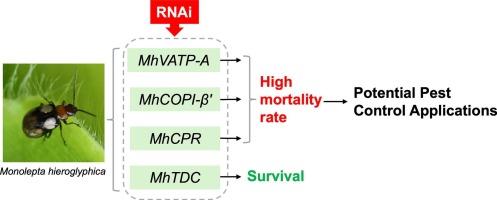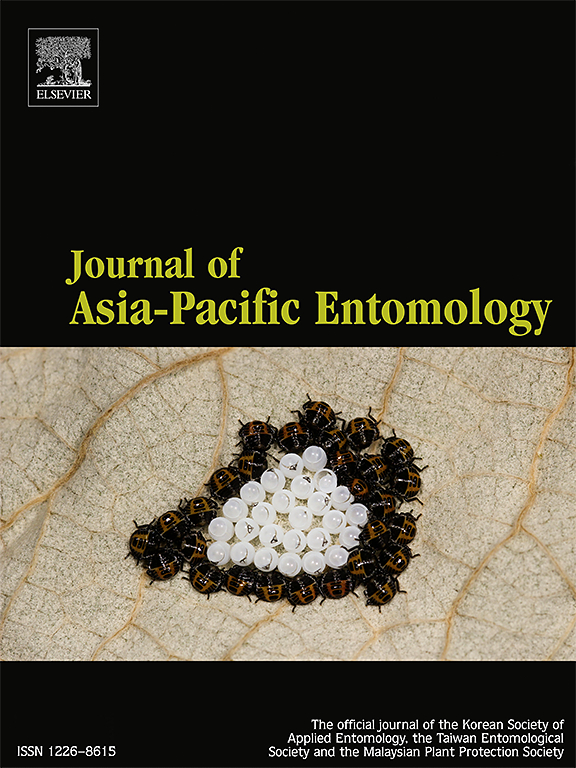Functional characterization of RNAi candidate target genes in Monolepta hieroglyphica (Motschulsky) for potential pest control applications
IF 1.3
3区 农林科学
Q3 ENTOMOLOGY
引用次数: 0
Abstract
Monolepta hieroglyphica (Motschulsky) (Coleoptera; Chrysomelidae) is a major agricultural pest affecting maize crops in northern and northwestern China. RNA interference (RNAi) technology offers a strategy for sustainable pest control by targeting and silencing specific genes, reducing reliance on chemical pesticides. In this study, we investigated four genes from M. hieroglyphica genome: V-type ATPase subunit A (MhVATP-A), coat protein complexes I β’ subunit (MhCOPI-β’), cytochrome P450 reductase (MhCPR) and tyrosine decarboxylase (MhTDC) as potential RNAi targets for RNAi-mediated pest control. Through dsRNA injections in adult, we successfully achieved gene silencing in M. hieroglyphica, resulting in significantly reduced expression levels of the target genes. Silencing of MhVATP-A and MhCOPI-β’ resulted in a marked increase in mortality (60–80%), suggesting that these genes play critical roles in essential physiological functions, such as cellular PH regulation and vesicular transport. In contrast, MhCPR suppression resulted in moderate mortality (30%), indicating that while it influences detoxification processes, it may be less effective as a primary target for pest control. MhTDC silencing, involved in nervous system regulation, had no significant impact on adult insect survival, possibly due to compensatory physiological mechanisms. Overall, our findings demonstrate the potential of RNAi technology to target essential genes in M. hieroglyphica, leading to significant insect mortality. The results highlight MhVATP-A and MhCOPI-β’ as promising targets for RNAi-based transgenic maize, offering a species-specific approach for sustainable pest management in maize production. Further investigation is required to assess the effectiveness of RNAi across different development stages and environmental conditions.

象形单掌虫RNAi候选靶基因的功能分析及其在害虫防治中的应用
象形单肢象(Motschulsky)(鞘翅目;金曲蝇是影响中国北方和西北地区玉米作物的主要农业害虫。RNA干扰(RNAi)技术通过靶向和沉默特定基因,减少对化学农药的依赖,为害虫的可持续控制提供了一种策略。在这项研究中,我们研究了来自象形草基因组的四个基因:v型atp酶亚基A (MhVATP-A),外壳蛋白复合物I β ‘亚基(MhCOPI-β ’),细胞色素P450还原酶(MhCPR)和酪氨酸脱羧酶(MhTDC)作为RNAi介导的害虫控制的潜在靶点。通过在成人体内注射dsRNA,我们成功实现了M. hieroglyphica的基因沉默,导致靶基因的表达水平显著降低。MhVATP-A和MhCOPI-β '的沉默导致死亡率显著增加(60-80%),表明这些基因在基本生理功能中发挥关键作用,如细胞PH调节和囊泡运输。相比之下,MhCPR抑制导致中等死亡率(30%),这表明尽管它影响解毒过程,但作为害虫防治的主要目标可能效果较差。MhTDC沉默参与神经系统调节,对成虫存活无显著影响,可能存在代偿生理机制。总的来说,我们的研究结果表明,RNAi技术有潜力靶向象形虫的必需基因,导致显著的昆虫死亡率。结果表明,MhVATP-A和MhCOPI-β′是基于rnai的转基因玉米的有希望的靶点,为玉米生产中的可持续害虫管理提供了一种物种特异性的方法。需要进一步的研究来评估RNAi在不同发育阶段和环境条件下的有效性。
本文章由计算机程序翻译,如有差异,请以英文原文为准。
求助全文
约1分钟内获得全文
求助全文
来源期刊

Journal of Asia-pacific Entomology
Agricultural and Biological Sciences-Insect Science
CiteScore
2.70
自引率
6.70%
发文量
152
审稿时长
69 days
期刊介绍:
The journal publishes original research papers, review articles and short communications in the basic and applied area concerning insects, mites or other arthropods and nematodes of economic importance in agriculture, forestry, industry, human and animal health, and natural resource and environment management, and is the official journal of the Korean Society of Applied Entomology and the Taiwan Entomological Society.
 求助内容:
求助内容: 应助结果提醒方式:
应助结果提醒方式:


